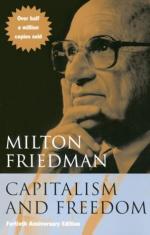|
This section contains 547 words (approx. 2 pages at 400 words per page) |

|
Capitalism and Freedom Summary & Study Guide Description
Capitalism and Freedom Summary & Study Guide includes comprehensive information and analysis to help you understand the book. This study guide contains the following sections:
This detailed literature summary also contains Topics for Discussion and a Free Quiz on Capitalism and Freedom by Milton Friedman.
Capitalism and Freedom was written by Milton Friedman in 1962 to defend what Friedman calls the liberal (or today what would be called libertarian) approach to economic policy in the face of very different views defended by social democrats or false liberals, as Friedman would have it. The book was a massive success, defending the economic institutions of the United States prior to the Great Depression. Friedman's book is full of proposals that will seem shocking to some today but were particularly radical for his time.
In fact, many of Friedman's proposals have been influential. Today, the flat tax he advocated has spread throughout former communist countries, his floating exchange rate is used throughout the world and school voucher programs are becoming more popular. Free trade has increased substantially since 1962, though not to the radical extent Friedman proposes. The book was widely read, selling half a million copies since 1962. As a Nobel Laureate and monetary economist, Friedman's influence extends far beyond this book, but it is in Capitalism and Freedom that many of his core economic ideas are explained most clearly to the public.
Capitalism and Freedom contains an introduction, conclusion and twelve modestly sized chapters, all of which focus on one or another economic concern. The introduction defines Friedman's conception of a liberal, the classical liberal of the 18th and 19th century who defends the decentralization of power, limited government, constitutionalism and the rule of law, cosmopolitan free trade, private property rights, free enterprise economics, and the standard liberal freedoms of speech, press, religion and the like, along with the advancement of the social progress of women. He also includes support for Civil Rights in the list, something somewhat controversial for his day.
Chapter 1 argues that economic freedom and political freedom are related and that if one wants to preserve and strengthen democratic institutions, economic freedom is a necessity. In Chapter 2, Friedman outlines the liberal conception of the role of government, which is merely to protect property, enforce the law, reduce negative externalities, manage money and—perhaps—support a weak social safety net. In Chapter 3, Friedman argues that the Federal Reserve's failure to manage the money supply caused the great depression and proposes a consistent price inflation rule as Fed policy.
Chapter 4 argues to abolish the Bretton Woods system in favor of floating exchange rates and Chapter 5 argues against the use of fiscal policy to stimulate the economy. In Chapter 6, Friedman defends the use of school vouchers in the place of public schools and in Chapter 7, Friedman argues that capitalism will reduce discrimination and is superior to forced integration. Chapter 8 argues that private monopoly is bad but that the cure is often worse than the disease; he also claims that corporate "social responsibility" is a damaging idea.
Chapter 9 defends what many see as Friedman's most radical idea, ending occupational licensure. Chapter 10 argues against the redistribution of income for egalitarian reasons. Chapter 11 argues that many social welfare measures fail to do what they intend and criticizes social security. In Chapter 12, Friedman defends a negative income tax to replace the welfare state in the elimination of poverty. Chapter 13 concludes that most of what is good economically comes from the market, not the government and that the government should be limited in its power.
Read more from the Study Guide
|
This section contains 547 words (approx. 2 pages at 400 words per page) |

|



